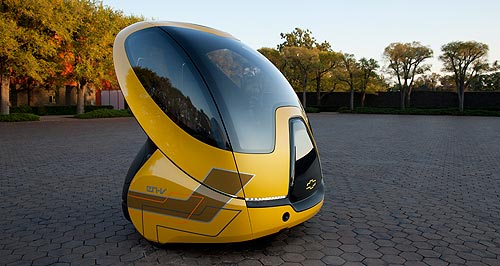GM unveils next-gen EN-V city runabout
BY HAITHAM RAZAGUI | 17th Oct 2011

The first-generation concept that made its world debut at the 2010 Shanghai World Expo was unveiled in three versions, one of which – the nautically-inspired Xiao that resembled a deep-sea diving suit – was crafted by Holden’s team at Port Melbourne.
However the revised EN-V – which stands for Electric Networked-Vehicle – most closely resembles the Miao version styled by GM’s California-based Advanced Design Studio and wears Chevrolet badges.
Chevrolet vice-president for global marketing and strategy Chris Perry said the concept bears the 100 year-old bow-tie brand as a reference to Chevrolet’s history of “making advanced technology that improves customers’ lives accessible and affordable”.

GM aims to use the updated concept for “pilot demonstration programs in megacities around the world” to determine its practicality in real-world scenarios.
Originally conceived as a way of addressing issues of traffic congestion, parking, safety and energy consumption that affect the modern city, EN-V aims to preserve the sense of freedom associated with personal mobility.
Refinements to the updated EN-V include the addition of climate control, better adaptability to weather and road conditions, and some personal storage capacity.
Carry-over technology includes its battery-powered, Segway-based electric drivetrain, network connectivity, and the ability to avoid collisions and drive autonomously.
EN-V’s autonomous driving capability comes from a combination of technologies including satellite navigation, vehicle-to-vehicle communication and an array of proximity sensors.
Communicating with other vehicles and traffic infrastructure enables the EN-V to find parking spaces, charging points and select the least congested route to the programmed destination – a technology that could reduce congestion by enabling vehicles to work together in ensuring a constant traffic flow.
Naturally, inter-vehicle communication coupled with the proximity sensing equipment also has the potential to improve safety by eliminating human error and enabling vehicles to pre-empt and avoid – or at least mitigate – a collision, and even detect the presence of emergency vehicles to ensure they get a clear route.
Drivers, freed from having to concentrate on driving, can take advantage of built-in wireless networking to conduct business or social communications while travelling.
The technology could enable people who do not usually drive – or are unlicensed – to benefit from personal transport.
Able to travel up to 40 kilometres on a single charge of its lithium-ion battery pack – which can be replenished using a conventional household power outlet – GM claims the EN-V’s range is “acceptable” for most urban journeys.
GM director of advanced technology vehicle concepts Chris Borroni-Bird said the EN-V “provides an ideal solution for petroleum- and emission-free urban transportation that is free from congestion and crashes”.
“This technology platform of electric propulsion, sensors, wireless communications and GPS-based navigation is likely to migrate from the EN-V concept to other automobiles and could lead the way to safer, cleaner vehicles in the future,” he said.
GM China announced in April that it would develop a next-generation EN-V to take part in real-world testing on public roads in China, as part of a memorandum of understanding it signed that month with the Sino-Singapore Tianjin Eco-City Investment and Development Co Ltd (SSTEC).
Mr Borroni-Bird added that Chevrolet is also considering other countries for potential pilot programs, including GM’s US home turf.
EN-V is just one of several ideas being worked on by various vehicle manufacturers for a future in which more than 60 per cent of the world’s population – expected to have swelled to 8 billion people by 2030 – reside in urban environments.
GM’s European arm is also working on an electric commuter concept – admittedly less radical and lacking the autonomous driving aspect – with the Opel Rak-e concept unveiled at the Frankfurt motor show last month.
Opel is developing a business case for the electric two-seater to be put into production and go on sale for less than $14,000.
Audi also unveiled its conceptually similar Urban Concept at Frankfurt, while Volkswagen showed its single-seat Nils city car, described as a “realistic proposition” for commuting in the year 2030.
Renault is already taking orders for its tandem-seated electric Twizy city runabout and alliance partner Nissan is also working on one – thought to be based on its quirky 2009 Land Glider concept car that leans into corners like a four-wheeled motorcycle.
Several manufacturers – including GM, Ford and Audi – are working on vehicle-to-vehicle communications that will enable greater safety and congestion avoidance to become reality, and BMW recently showcased a self-driving 5 Series.
Volvo has been working on vehicle ‘platooning’ – which involves cars forming a ‘road train’ behind a lead vehicle and taking over the controls, leaving the driver to rest or carry out other tasks.
Mr Perry described the EN-V as “a possible solution for global customers living in markets where alternative transportation solutions are needed”.